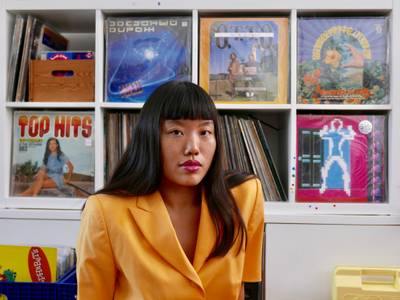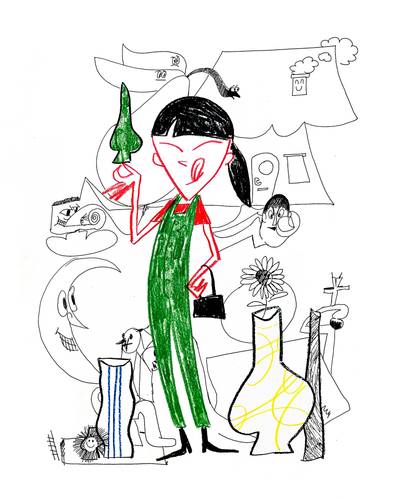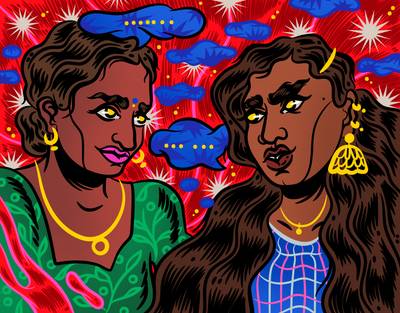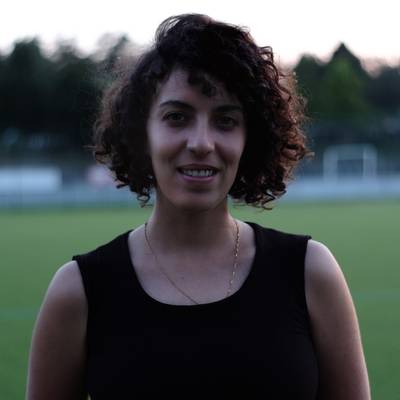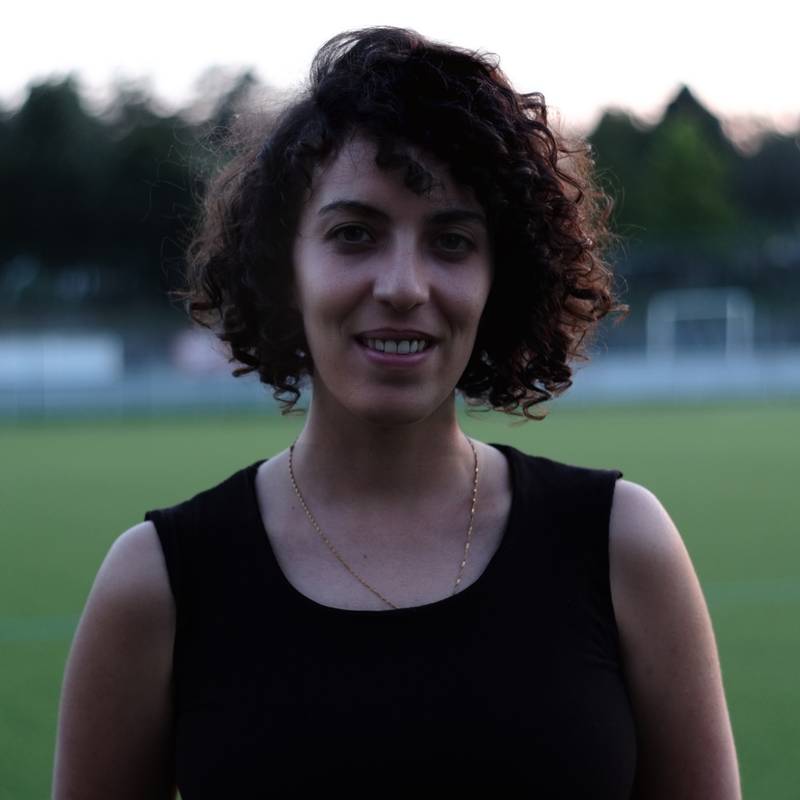

Photo: Iswanto Hartono
Adele Jarrar (PS, 1992) is an independent curator, cultural worker, and researcher with a focus on self-organization, artist-run initiatives, and alternative modes of cultural production. Adele worked as a curator, researcher, and writer with the collective The Question of Funding at Documenta 15 in Kassel, Germany, and was a resident at the Unidee Residency Summer 2022: Sustaining Embedded Arts Practice in Biella, Italy.
Noor Abed (b. 1988) is a Palestinian artist who works at the intersection of performance and film. Through a process of image making, her works create situations where social possibilities are both rehearsed and performed. At the time of preparing this interview, Noor was (and still is) in Amsterdam, Netherlands, as an artist in residence at the Rijksakademie, and I was in Ramallah, Occupied Palestine. This text was developed gradually over the span of two months, utilising shared Google Docs and email exchanges. My approach to conducting the interview was to experience the profound impact of Noor’s work, particularly her captivating film titled ‘Our Songs Were Ready for All Wars to Come’. This film, produced amidst Covid-19, inspired me to delve deeply into its themes, production process, and visual language, providing readers with a comprehensive understanding of Noor’s artistic practice. In preparing this text, my intention was to zoom in and out of the film’s narrative and production process, thereby enabling a nuanced interpretation of its contextual significance, both locally and globally.
ADELE: As I prepared for this interview, my initial inclination was to explore the various projects you have undertaken. However, upon viewing your art film, “Our Songs Were Ready for All Wars to Come (2021),” I was moved by its vast array of subjects that can be discussed, on many levels. I found it fitting to use this specific work as a point of departure to investigate the cultural ecosystem within which you operate. As I immersed myself in the film’s enthralling imagery, I found myself captivated by your artistic process. To start, could you elaborate on the essence of the film for someone who has not yet had the opportunity to experience it?
NOOR: I would perhaps describe it as a piece that came out of my guts, filmed at a site that haunted my dreams for years. The film unfolds and connects a series of choreographed scenes of everyday rituals in a community. The time in which we are is uncertain, yet the place/site is very present. The film was shot in the village of Al-Jib, northwest of Jerusalem, a few kilometres away from my home village. It came from many visits and dialogues with a particular location in the village; an empty, dried, huge pool or water well, caves, and smaller holes opening to the underground.
Maya Khaldi sings a song, which serves as the only narration in the movie. Its lyrics are a collage of different folktales:
whoever drinks from it becomes a gazelle,
gazelle
gazelle
touch the same water of bitterness
*O time, leave me
O time, come back *
*come back
come back *
Myth approaches history from a different perspective; it reflects a reality other than the one history offers. It can be seen as a collective dream and public imagination—a place where the marginalised overturn the characteristics of the dominant discourse and attempt to rewrite reality as they know it.
While rewatching the film, I was struck by your ability to translate folklore in the form of songs and tales into a symbolic avant-garde visual language that also feels rooted in its local context. How did you manage to create a distinct visual language for this film, and what references, especially local ones, if any, influenced your creative process?
The super 8mm film, as a medium, was essential in grounding the content of this work. Within a wider interest in image-making and its relationship to colonialism, particularly to Palestine in this case. I wanted to work around the notion of nostalgia, not only in relation to analogue film, but the nostalgia that is connected to Palestine as land and history - remembering and longing for a utopian past that does not exist anymore. I wanted to create an image of a haunted present, liberated from a fixated time, a kind of archival document that breathes.
The visual language identity that I create combines the forms of the staged ‘performative’ and the ‘documentary’. It stems from an urgency in establishing a new representational mode of the documentary that is intertwined with aspects of the ‘magical’ and, the ‘mythical’, inspired by everyday life’s contradictions. Myth approaches history from a different perspective; it reflects a reality other than the one history offers. It can be seen as a collective dream and public imagination—a place where the marginalised overturn the characteristics of the dominant discourse and attempt to rewrite reality as they know it.
My purpose here is to provide a liberating response—through image making—to the codes of colonial history and its tools of fragmentation and discontinuity by conveying the oppositions of real social conditions. My aim is to decentralise images of fixity while at the same time foregrounding the gaps, silences, and abscesses those fixed structures produce.
As references, one of my main ones, I think, is living and growing up in a village, with all that it entails—from mountains, caves, tales, and the communal aspect of life to the notion of the suburb—the margin is very inspiring to me. The presence of women and storytelling in that local context became the basis of how I create.
Another broader reference is the films of the Palestine Film Unit (PFU); for example, Mustafa Abu Ali and Hani Jowharieh’s films have always been something that I go back to. Those films were produced with the primary task of documenting the revolution and creating an archive of images. In my opinion, the fact that those films were produced from within, from the inside, rather than ‘about’ is an important factor in creating any work. And the books of the Palestinian poet and writer Hussein Barghouti always make me feel a new sense of the landscape around me—very familiar, yet stray.
Researching Palestinian folktales for a few years now, I have always been amazed by the communal aspect of these tales and at how much these communities are aware of the landscape around them - in every tale, the details of a stone, a cave, a particular side of a mountain, etc. They know it deeply; it’s theirs; they own it.
I am very moved by a sentence you mentioned now: “An attempt to rewrite reality as they [the marginalised] know it”. In what manner can folklore serve as a mechanism for resistance in anti-colonial struggles, and especially in Palestine, in your opinion?
I have been trying to think through a critical stance towards folktales as a source of knowledge while understanding folklore as a conscious collective comment about present life. Researching Palestinian folktales for a few years now, I have always been amazed by the communal aspect of these tales and at how much these communities are aware of the landscape around them - in every tale, the details of a stone, a cave, a particular side of a mountain, etc. They know it deeply; it’s theirs; they own it.
Can we turn folklore into a source of learning - a knowledge source that informs us about social struggles that otherwise go unnoticed by the powerful? Personally, through investigating structures of social movements and spaces that are informed by everyday communal life, I aim to grasp the critical thinking that is grounded in folklore and indigenous positions - which are capable of challenging the fixed mainstream ideologies. It is a form of resistance that goes beyond the binary mode of action-reaction. How can we re-think, through folktales, the way we live? And what routes do folktales provide us to intervene in the world around us? Folktales are capable of claiming alternate historical narratives for Palestine, and therefore, they create a parallel space that merges with the main political reality from another perspective and highlights its absurdity.
Your insightful observation regarding the ability of folktales to lay claim to alternative histories, as well as their potential to serve as a repository of our overlooked struggles, holds significant importance. Given the inherently interpretive nature of this art film, perhaps this interview presents a valuable opportunity to review concealed nuances present within certain scenes in your film. Could you elaborate on the meanings or origins encapsulated within the following specific scenes?
![[2:26]](/images/kikecpm7qpsbjjoyrdnp-657w.jpeg)
![[2:26]](/images/kikecpm7qpsbjjoyrdnp-lqip.webp)
[2:26]
![[8:38]](/images/ivryngqrkacdf5lsqzuw-659w.jpeg)
![[8:38]](/images/ivryngqrkacdf5lsqzuw-lqip.webp)
[8:38]
![[5:59]](/images/m0bqzsogthuwz5fjeuyh-648w.jpeg)
![[5:59]](/images/m0bqzsogthuwz5fjeuyh-lqip.webp)
[5:59]
![[11:08]](/images/clfmxqpqhibklabiknrx-653w.jpeg)
![[11:08]](/images/clfmxqpqhibklabiknrx-lqip.webp)
[11:08]
I find it difficult to speak about the origin of each of the scenes separately, perhaps because, in my process, they are all connected to each other, originating from the same core. Each scene connects to the others. When I was editing, I thought of the structure of a circle, or a loop. The site itself had many holes and circular structures, as we see in the first two scenes you mentioned. The choreography in all scenes revolved around constructing movements of ‘rituals’, specific to this particular site. The performers’ bodies know it deeply, as if born from it, touching it. The ritualistic construction is an attempt for me to understand our own history and self-identification. The scenes are signs of what was lost, forgotten, or unsaid. They appear with a ghostly texture, letting us know that they exist.
I imagined the scenes in three layers - underground, in transition, or in between, and in the foreground. The underground scenes—the woman singing from deep down the hole and the two women entering the cave—are the ones that are in transition, or in between the two worlds; they are people crawling up the stairs of the hole and the two scenes you mentioned here. The ones we see here, with women placing their heads in small holes, are like a ritual of mourning, of silence, looking into the darkness and slowly suggesting a reach of the underground, of the belly of that land.
I also imagined the film as songs, people, and creatures from the underground, moving and singing for survival. The foreground scenes/movement support that call. The scene of the two women dancing relates to the foreground category, for example. This scene in particular comes from a memory I had as a child, as my mother used to take me with her to weddings in the village. I was amazed to see women sitting, singing, and clapping in a circle while two of them came to the middle and started dancing against each other, as if competing. They called it the jump dance, and the one who lasts longer wins. And another woman comes to compete with her. I observed this so many times growing up, and it stayed with me. The fierce look, the joy, and the strength at the same time.
***This film was produced during the pandemic in 2021, which must have presented some unique challenges. Could you speak to the materialistic conditions of the production, including funding and navigating the filming process? Choice of location? Additionally, how did the pandemic impact the film’s production and artistic choices? ***
About a year before the pandemic, my father asked me one day to join him for a ride to show me the site, which he had recently discovered and felt a connection with. The place hit me the moment I saw it. Over the course of a year, I went there many times - sketching, listening, and dreaming. The place somehow never left me from the moment I first encountered it. It haunted me fully, and I trusted it. The site became the core character of the film, and my father became one of the producers of the work.
During the pandemic, I did more research and finalised the scenes, thinking that the pandemic would end soon. Filming during the pandemic was not easy; I had to change many scenes and cancel some; for example, I had a scene with thirty people that I cancelled completely. The performers in the film are family members, neighbours, and friends. Production under the pandemic gave me limitations that made me improvise more, learning how to work creatively under an unpredictable structure. The urge to make this film was stronger than the pandemic and the funding process - I don’t know how to describe it - I was sleepless. It had to be made somehow. Back then, I was teaching at Birzeit University and Al-Quds University. I produced the film independently on a low budget with my salary. Then, I got post-production grants that helped me develop and process the films.
It was mentioned before how this film is based on / a communal choreography of folktales. I can see that the film is not merely about communality, but also a product of a communal choreography of labour, love, and friendships. Collaboration is a prominent aspect of your artistic practice, and this film is no exception. You worked with other artists and friends such as Hamoudi Trad, Dirar Kalash, Dina Mimi, and Maya Khaldi, among others. Can you speak to how you approach collaboration and working with others in your artistic practice?
Collaboration, in its different forms, assists me in furthering my critical dialogue and understanding within the structures that the work inhabits. My broader research framework delves into notions of Social Choreography and the imaginary relationships of individuals, mostly questioning the ways we can analyse political and social ideologies through notions of choreography. It is an observation of collective social order and the practices of collective movement. I feel that the origin of my research interest is a collective one in the first place. Besides, both practices of performance/ or choreography, and filmmaking are collaborative on a structural level.
This film was born out of a process of various collaborations and conversations. My father, who introduced me to the location and assisted me in different ways on the ground while filming. Local historians that I met with influenced my research and knowledge about the site and its previous lives. Hamoudi Trad, the camera operator, who I worked with for several months before filming, where we visited the place, discussed the relation between the analogue medium and the proposed scenes, etc. Trad has been filming my work for many years, and it is a precious process of understanding and friendship. Similar to the musician and singer Maya Khaldi, with whom I have collaborated before and whose practice is inspirational to my work. In this film, Maya sang the song, which is the only narration in the film. Maya and I collaged the lyrics from Palestinian folktales that are mainly based around water wells and connected to communal rituals concerning transformation, mourning, and death. Also, the choreographer and dancer Noora Baker, for the dance scene, expanded my thoughts on movement, and worked on rehearsals before filming. Dina Mimi, for many conversations and support while developing the scenes. Dina also took analogue stills on set and was one of the performers in some scenes. I also collaborated with the musician and sound artist Dirar Kalash for the sound composition of the film, who worked for several months on the composition. I always feel that my process of creating has to be based on dialogues, observations, friendships, and daily encounters that I trust and follow until the end.
